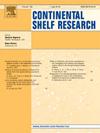人类踩踏和车辆交通对亚马逊大潮沙滩上小动物和线虫分布格局的影响
IF 2.2
3区 地球科学
Q2 OCEANOGRAPHY
引用次数: 0
摘要
康乐活动是干扰沙滩的重要来源,并对小型动物群落产生负面影响,因为它们改变了物种的丰度、多样性和/或分布。在此,我们首次报道了娱乐活动对亚马逊沙滩上小型动物群落和线虫群落分布格局的影响。在2017年连续四个月不同海滩使用强度(6月-假期前,7月-假期月,8月和9月-假期后)对两个对比鲜明的海滩进行了采样,涉及干扰(城市:Atalaia;和受保护的:Corvinas)。随着时间的推移,两个海滩的物理沉积物变量保持不变,而不同时期的沉积物压实度存在差异。沉积物压实作用被认为是造成滩头动物群落和线虫群落结构差异的最重要因素,并与游憩活动强度有关。总体而言,在Atalaia海滩观测到不同时期和采样站之间密度和丰富度的变化。度假前,Atalaia海滩有3个区系(上潮间带、中潮间带和低潮间带),而在度假期间,只有2个区系(上潮间带和中低潮间带)。另一方面,在整个研究过程中,科维纳斯海滩保持不变。因此,最初的假设是,娱乐活动引发了小动物和线虫的结构和组成的变化,降低了群落的丰富度和丰度,这一假设得到了证实。此外,本文研究的一些分类群的脆弱性,特别是桡足类和缓步类,以及线虫属Chromadorita和Daptonema,表明它们可能是娱乐活动的潜在指标。本文章由计算机程序翻译,如有差异,请以英文原文为准。
Human trampling and vehicle traffic affect meiofauna and Nematoda distribution patterns in Amazonian macrotidal sandy beaches
Recreational activities are important source of disturbance on sandy beaches and have a negative effect on meiofauna communities as they alter species abundance, diversity, and/or distribution. Here, we report for the first time the effects of recreational activities on the distribution patterns of meiofauna communities and Nematoda assemblages of Amazonian sandy beaches. Sampling was performed during four consecutive months with different beach use intensity in 2017 (June – before vacation, July – vacation month, August and September - after vacation months) on two contrasting beaches regarding disturbance (Urban: Atalaia; and Protected: Corvinas). Physical sediment variables remained constant over time in both beaches, whereas differences were found in sediment compaction over the periods. Sediment compaction was considered the most important factor for the differences observed in meiofauna community and Nematoda assemblage structures in the beaches, and it was related to intensity of recreational activities. Overall, variations in density and changes in richness between periods and sampling stations were observed in Atalaia beach. Before the vacation three faunal zones were distinguished in Atalaia beach (upper intertidal, intermediate intertidal, and low-intertidal), whereas in the vacation period only two faunal zones were distinguished (upper-intertidal and intermediate-low intertidal). On the other hand, Corvinas beach remained the same throughout the study. Thus, the initial hypothesis that recreational activities trigger changes in the structure and composition of meiofauna and Nematoda, reducing richness and abundance of the community, was confirmed. Furthermore, the vulnerability of some taxa studied here, particularly Copepoda and Tardigrada, and the Nematoda genera Chromadorita and Daptonema indicates that they might be potential indicators of recreational activities.
求助全文
通过发布文献求助,成功后即可免费获取论文全文。
去求助
来源期刊

Continental Shelf Research
地学-海洋学
CiteScore
4.30
自引率
4.30%
发文量
136
审稿时长
6.1 months
期刊介绍:
Continental Shelf Research publishes articles dealing with the biological, chemical, geological and physical oceanography of the shallow marine environment, from coastal and estuarine waters out to the shelf break. The continental shelf is a critical environment within the land-ocean continuum, and many processes, functions and problems in the continental shelf are driven by terrestrial inputs transported through the rivers and estuaries to the coastal and continental shelf areas. Manuscripts that deal with these topics must make a clear link to the continental shelf. Examples of research areas include:
Physical sedimentology and geomorphology
Geochemistry of the coastal ocean (inorganic and organic)
Marine environment and anthropogenic effects
Interaction of physical dynamics with natural and manmade shoreline features
Benthic, phytoplankton and zooplankton ecology
Coastal water and sediment quality, and ecosystem health
Benthic-pelagic coupling (physical and biogeochemical)
Interactions between physical dynamics (waves, currents, mixing, etc.) and biogeochemical cycles
Estuarine, coastal and shelf sea modelling and process studies.
 求助内容:
求助内容: 应助结果提醒方式:
应助结果提醒方式:


